

With Mars the closest approach ever, lots of highly detailed images are expected. Unfortunately, the planet never gets very high over the horizon as seen from San Diego, so atmospheric turbulence, dispersion, and attenuation are potential problems. Since other amateur astronomers are having success with webcams, I decided to see the difference for myself. I purchased a Philips ToUcam, a USB webcam with a 640x320 pixel color CCD. I laid a new Cat5 cable along the other cables from my telescope to my indoor computer, and used a USB extender to allow operation over the 80 foot distance.
I was unsure of the signal and noise levels, but I was pleasantly surprised that I could saturate the webcam at the minimum gain with only 50 millisecond exposures, even when operating at F/33. This allows capturing 10 frames per second, so focusing is simplified. One-shot color also simplifies the processing, although the red and blue frames still need some shifting (about 4 pixels in doubled (1280x960 pixel) resampled image space). Image acquisition, frame alignment and stacking was accomplished with K3CCDTools software, and final image processing (only an unsharp mask) used Maxim DL software. To provide F/33 imaging, I used the barlow lenses I already had - a TeleVue 2.5X Powermate followed by a Celestron 2x Ultima barlow. This combination gives a plate scale of about 0.14 arcsec/pixel. The point spread function of the webcam is about 2 pixels, so the effective image sampling is about 0.25 arcsec, just at the Nyquist limit for my telescope.
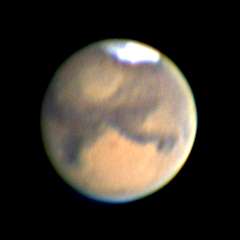
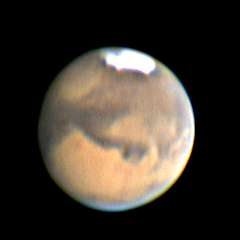
Left image: August 2, 00:45 am PDT, 600 frames captured, best 118 summed, 50 msec exposures. Right image: 2:20 am PDT, 2000 frames captured, best 100 summed.
The first tests of the webcam finally came after an unusually cloudy summer in San Diego. I tested the webcam on some star images early in the evening, and was able to take images until slightly after 2 am PDT. The seeing was average, with the limb of Mars shimmering between exposures. Averaging many frames reduced noise to acceptable levels. Image processing was limited to unsharp masking and increasing color saturation. For some reason, maximum entropy processing was not effective, perhaps because the frames did not have a good background level. The exposure was limited to 50 msec to prevent the bright south polar cap from saturating; next time, I'll try longer exposures to record the surface markings, and a separate series to record the polar cap. Since the dynamic range of the webcam is much smaller than the ST-7E SBIG camera I've used in the past, I need to overlap exposures to capture both bright and dim regions.
The blue ring on the bottom may be due to atmospheric dispersion that wasn't entirely compensated; more experienced Mars observers may want to verify this.
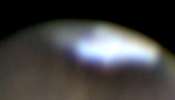
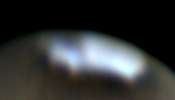
The same raw images were rescaled to show the features in the south polar cap.
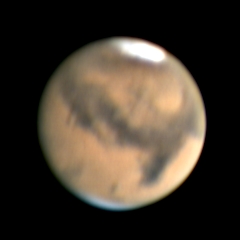
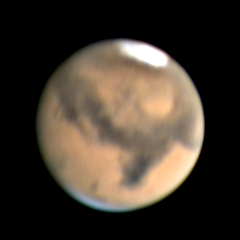
Left image: August 9, 0105 am PDT, 400 frames captured, best 80 summed, 100 msec exposures. Right image: 01:48 am PDT, 400 frames captured, best 80 stacked
After the first Mars sessions last week, and after lots of image processing tests, the best technique for me is to capture 400 frames over 40 seconds and stack the best 20%. This gives enough frames where the noise is minimal and the details remain the sharpest. I took 33 series of frames from about midnight until 3 am, then processed each series and selected the two best for posting here. Mars was still pretty low for the early series, and the seeing seemed to get slightly worse after 2 am. Toward the end of the evening, the transparency also started to decrease, due to the marine layer getting closer and thicker. Happily, the difference between most of the series was very difficult to detect, which means the seeing deteriorated very slowly.
To show what the atmospheric turbulence is like, click on the single raw frame below. That will download a 650kB avi movie made from the first 33 raw frames captured as part of the images shown above. While it looks like a lot of wavering, the distortion is actually less than an arcsecond, or all of the details would have disappeared. I would appreciate other Mars viewers sending me (dbruns@stellarproducts.com) comments on how this movie looks compared to the visual seeing they get at their location. If enough people respond, I'll post some of their comparative seeing comments here. I rated the seeing at a 7 on a scale of 10.
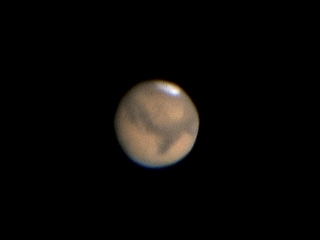
Between Mars images, I moved the telescope to Markab, a 2.5 magnitude star in Pegasus, and captured a series of frames to measure the telescope-Barlow-IR filter-Barlow-CCD system point spread function (PSF). While Mars was at 40 degrees above the horizon, Markab was 25 degrees higher, so it had somewhat better seeing. The resulting PSF, taken by summing 80 frames, turned out to be only 3.5 pixels wide, or 0.5 arcseconds FWHM, which is the diffraction limit for this telescope. The shape is very clean, with no extended radial wings, as shown in the left figure below. A vertical profile through the center is shown in the middle figure (at 0.14 arcsec/pixel). The first Airy ring is not visible in these exposures, since it would be only a few percent of the central peak. Another series of frames with longer exposures saturated the central peak, but clearly shows the first diffraction ring. That figure is on the right. After these images were collected, I very slightly tilted the primary mirror to better collimate the telescope, centering the ring a little better. I didn't take time to collect more stellar images. The Mars images above were collected before and after the collimation, so it looks like it didn't make any practical difference; the seeing dominated the resolution. Hopefully, the seeing will improve over the next month.
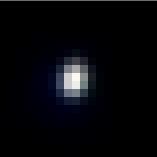
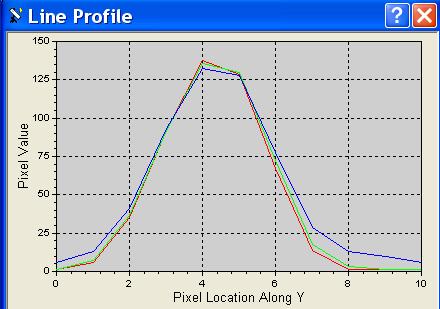

Left image: August 16, 0115 am PDT, 400 frames captured, best 80 summed, 100 msec exposures.
The seeing wasn't as good for this session, and there were lots of high, thin clouds (Click on the image to see a movie of the first 30 frames (450kB file)). It has been hotter than normal in San Diego, so that might have made a difference in the seeing. Due to the clouds, I used 100 sec exposures, but then the best series had the red channel slightly saturated in the center of the planet, resulting in the light green region in the center. Next time, I'll make sure to look for saturation. Unsharp masking and color plane re-alignment in MaxImDL software.
Mars, August 23-24, 2003
Left image: August 23, 10:45 pm PDT, 400 frames captured, best 80 summed, 100 msec exposures. Right image: August 24,1:37 am PDT, 1000 frames captured, best 99 summed, 50 msec exposures.
The seeing still wasn't very good (click on the right image to see a movie of the first raw 33 frames (450 kB file)), so I continued some experiments to determine the best image capture techniques.
I compared images captured with no IR filter with images captured with an old IR filter that has a little leakage, and images captured with the original ToUcam IR filter, which has no leakage, but passes a narrower band of red light. (The spectral leakage measurements will be posted as soon as I finish calibrating the data.) The test images confirmed the results expected from the spectral measurements. If no IR filter is used, then the blue image is contaminated with red signal and the resolution and contrast suffers from dispersion and spectral overlap. If a filter that leaks just a little is used, then the blue North polar hood is swamped by the red signal. The best filter I have available is the original one salvaged from the original ToUcam lens assembly. Other commercial IR-cut filters may be acceptable.
I also did experiments with longer avi files and shorter exposures with higher gain. Capturing 1000 frames over 100 seconds and using the best 10% seemed to produce better results than capturing a 40 second series and using the best 20%. Summing the best 20% of the longer series started to reduce resolution. Similarly, using a 50 msec exposure with the gain turned up just 10% seemed better than using a 100 msec exposure with the gain set at zero.
Toward the end of the session, the raw image contrast seemed a little low, even though Mars was near the meridian. Examining the secondary mirror with a flashlight showed a little extra haze that could have been from dew. I'll take the mirrors out, clean them, and recollimate before the next observing session.
Left image: August 29, 11:12 pm PDT, 1000 frames captured, best 99 summed, 100 msec exposures. Right image: August 30,1:35 am PDT, 1000 frames captured, best 99 summed, 100 msec exposures.
The fog started rolling in from the Pacific Ocean about midnight, so the transparency also decreased. The last images also had some dewing of the secondary mirror, so before the next imaging session, I'll wrap the secondary holder in aluminum foil to reduce radiation cooling. Otherwise, the seeing was about 7/10. Click on the left image to see the first 50 raw data frames.
Left image: August 31, 00:23 am PDT, 1000 frames captured, best 99 summed, 100 msec exposures. Click on the image to see the first 50 raw data frames. Click here to see the first 50 frames of a defocused image, focused instead on the high-altitude turbulence. From some rough estimates, the telescope is then focused at about a 13 km range. Since Mars was only about 14 degrees above the horizon, this places the layer about 4 km above the city of San Diego. This seems a bit low, but its at least in the ballpark. The waves of turbulence show how the distortions affect the fine detail over different parts of the planet.
Before imaging Mars, I placed a 5" mask to better determine the seeing based on Pickering's aperture. For stars over about 50 degrees in altitude the Airy disk was stable and the first ring was just slightly wavering - that's a whole lot better than with the full 10" aperture, where the first ring would sometimes disappear. At the altitude of Mars, the first ring was just a little worse. These numbers correspond to Pickering seeing of 8/10 down to about 5/10. At the lower altitude, the seeing isn't so much worse, but it seems the isoplanatic patch, the area over which the wavefront is essentially constant, is smaller, leading to the wavering edges. In a month or so, Mars will rise to over 50 degrees as seen in San Diego, while the apparent diameter will only shrink by a factor of 2. It will be interesting to see if these effects cancel, and the same surface resolution will be possible. In 2005, Mars will be much higher in the sky, and not too much smaller. Can we get two apparitions of Mars in a row without major dust storms?
Left image: September 5, 9:50 pm PDT, 100 msec exposures. Center: September 5, 11:03 pm PDT, 50 msec exposures. Right: September 6, 00:23 am PDT, 50 msec exposures. Each image used 1000 frames captured, best 99 summed. Click on the right hand image to see the first 50 raw data frames.
Mars was still pretty low in the sky when the first image was taken, so its resolution is not as good as the later ones, but it showed that the seeing was going to be pretty good. The seeing at higher altitudes was 8 to 9/10 on the Pickering scale with a 5" aperture. The other pictures were taken at shorter exposures to prevent saturating the polar cap, shown here for the two images, at a lower brightness. It looks like the entire cap might disappear before November! (Compare a similarly oriented picture at the top of this web page).
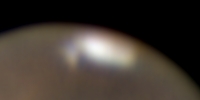
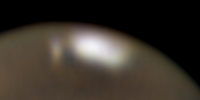
Left image: September 13, 9:13 pm PDT, 100 msec exposures. Right: September 13, 11:11 am PDT, 100 msec exposures. Each image used 1000 frames captured, best 99 summed. Click on the right hand image to see the first 50 raw data frames.
Seeing was average, perhaps (5 to 6) out of 10, with clear skies until about 11:30 pm, when high clouds came in and rapidly got heavy. The best images tonight were taken slightly before Mars reached the meridian. Compare these images to the ones on the top of the page taken August 9, where the polar cap was much larger.
September 13, 10:30 pm PDT, 100 msec exposures. Seeing average. Click on the picture to see the first 50 raw data frames. The coastal marine layer moved in shortly after this series, so I had to stop well before the planet was high in the sky.
September 13, 9:50 pm PDT, 100 msec exposures. Seeing average. Click on the picture to see the first 50 raw data frames. The coastal marine layer moved in even earlier tonight. This image series was taken with the gain set at 40%, instead of the normal 0 to 10%, just to get a good signal. The clouds varied transparency during the exposures, so I was interested in seeing how K3CCDtools handled the wide range - apparently, it ignored that aspect, and picked the best frames just as well as if there were no varying clouds. The final image is a little noisier due to the low signal.
Left image: October 12, 8:50 pm PDT, 50 msec exposures. Right: October 12, 10:00 am PDT, 100 msec exposures. Each image used 1000 frames captured, best 99 summed. Click on the right hand image to see the first 50 raw data frames.
Seeing was average, perhaps (5 to 6) out of 10, with the first clear skies in about a month. The complete disk is no longer seen, and the planet has shrunk quite a bit - the image scale is always the same.
Left image: December 13, 6:24 pm PST, 50 msec exposures. Center: Guide 8 image, slightly blurred, for 6:24 pm. Right: 7:58 pm PST, 50 msec exposures. Each image used 1000 frames captured, best 99 summed. Click on the left image to see the first 50 raw data frames in a short movie.
Seeing was slightly below average, (4 to 5) out of 10, but hard to compare to the summertime Mars images because it is so much smaller now - only 9.8 arcsec diameter. The image scale here is the same as the previous images. Skies were not cloudy, but had a slight haze.
Mars is finally pretty high in the sky, so I thought I could take some good images before I started taking Saturn images later in the evening. A winter storm was expected, but it stayed a bit north, producing only average seeing here in San Diego. These were the first images since the San Diego firestorms of last month, and my telescope was incredibly dirty. Luckily, the inside of the optical tube assembly and mirror was pretty clean, so I postponed cleaning them until these images were taken, not wanting to lose the same alignment I've been used to.
The processed image in the early evening looked nothing like the Guide8 simulation (shown in the center), so I thought maybe the time was set incorrectly. I haven't heard of any dust storms, and with several Mars probes arriving shortly, I thought that would be in the news. If this is a dust storm, it graciously waited until Mars appeared small!
Mars, January 10, 2004
January 10, 6:21 pm PST, 100 msec exposures. Image used 1000 frames captured, best 99 summed. Click on the image to see the first 50 raw data frames in a short movie.
Seeing was below average, even though the altitude was near 61 degrees, due to a slight breeze coming from inland. The transparency was good, but the seeing suffered. The planet was only 7.8 arcsec diameter. The image scale here is the same as the previous images. Only a little detail is visible, probably more from the seeing than from dust storms (which seem to have cleared up, based on other reports). I can try one more time before Mars gets too small and low.
Seeing was below average, since the planet was seen looking over the next-door neighbor's house. This evening, I was able to image Venus, Mars, Jupiter, and Saturn. The sky was clear, due to a slight breeze coming from inland. The transparency was good, but the seeing suffered. The planet was only 5.5 arcsec diameter. The image scale here is the same as the previous images. Only a little detail is visible. This is probably the last image of Mars this season, unless a day of exeptional seeing is forcast.
Return to the Image Gallery index page
Return to Stellar Products home page